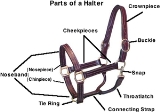
Halter
Encyclopedia

Livestock
Livestock refers to one or more domesticated animals raised in an agricultural setting to produce commodities such as food, fiber and labor. The term "livestock" as used in this article does not include poultry or farmed fish; however the inclusion of these, especially poultry, within the meaning...
and, occasionally, other animals; it fits behind the ears (behind the poll), and around the muzzle. To handle the animal, usually a lead rope
Lead (tack)
A lead, lead line, lead rope or head collar rope , is used to lead an animal such as a horse. Usually, it is attached to a halter. The lead may be integral to the halter or, more often, separate. When separate, it is attached to the halter with a heavy clip or snap so that it can be added or...
or lead shank is attached. On smaller animals, such as dogs, a leash
Leash
A leash is a rope or similar material attached to the neck or head of an animal for restraint or control...
is attached to the halter.
History
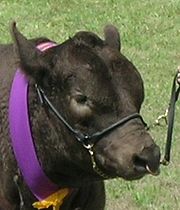
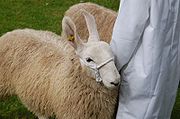
Bridle
A bridle is a piece of equipment used to direct a horse. As defined in the Oxford English Dictionary, the "bridle" includes both the headstall that holds a bit that goes in the mouth of a horse, and the reins that are attached to the bit....
or hackamore
Hackamore
A hackamore is a type of animal headgear which does not have a bit. Instead, it has a special type of noseband that works on pressure points on the face, nose, and chin...
. The word "halter" derives from the Germanic words meaning "that by which anything is held."
Uses
A halter is used to lead and tie up an animal. It is used on many different types of livestockLivestock
Livestock refers to one or more domesticated animals raised in an agricultural setting to produce commodities such as food, fiber and labor. The term "livestock" as used in this article does not include poultry or farmed fish; however the inclusion of these, especially poultry, within the meaning...
. Halters are most closely associated with Equidae
Equidae
Equidae is the taxonomic family of horses and related animals, including the extant horses, donkeys, and zebras, and many other species known only from fossils. All extant species are in the genus Equus...
such as horse
Horse
The horse is one of two extant subspecies of Equus ferus, or the wild horse. It is a single-hooved mammal belonging to the taxonomic family Equidae. The horse has evolved over the past 45 to 55 million years from a small multi-toed creature into the large, single-toed animal of today...
s, donkey
Donkey
The donkey or ass, Equus africanus asinus, is a domesticated member of the Equidae or horse family. The wild ancestor of the donkey is the African Wild Ass, E...
s, and mule
Mule
A mule is the offspring of a male donkey and a female horse. Horses and donkeys are different species, with different numbers of chromosomes. Of the two F1 hybrids between these two species, a mule is easier to obtain than a hinny...
s. However, they are also used on farm animals such as cattle
Cattle
Cattle are the most common type of large domesticated ungulates. They are a prominent modern member of the subfamily Bovinae, are the most widespread species of the genus Bos, and are most commonly classified collectively as Bos primigenius...
and goats and other working animal
Working animal
A working animal is an animal, usually domesticated, that is kept by humans and trained to perform tasks. They may be close members of the family, such as guide or service dogs, or they may be animals trained strictly to perform a job, such as logging elephants. They may also be used for milk, a...
s such as camel
Camel
A camel is an even-toed ungulate within the genus Camelus, bearing distinctive fatty deposits known as humps on its back. There are two species of camels: the dromedary or Arabian camel has a single hump, and the bactrian has two humps. Dromedaries are native to the dry desert areas of West Asia,...
s, llama
Llama
The llama is a South American camelid, widely used as a meat and pack animal by Andean cultures since pre-Hispanic times....
s, and yak
Yak
The yak, Bos grunniens or Bos mutus, is a long-haired bovine found throughout the Himalayan region of south Central Asia, the Tibetan Plateau and as far north as Mongolia and Russia. In addition to a large domestic population, there is a small, vulnerable wild yak population...
s. Halters generally are not used on elephant
Elephant
Elephants are large land mammals in two extant genera of the family Elephantidae: Elephas and Loxodonta, with the third genus Mammuthus extinct...
s or on predators, though there are halters made for dogs.
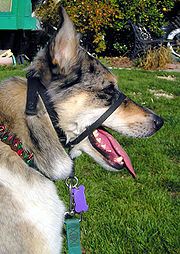
Lead (tack)
A lead, lead line, lead rope or head collar rope , is used to lead an animal such as a horse. Usually, it is attached to a halter. The lead may be integral to the halter or, more often, separate. When separate, it is attached to the halter with a heavy clip or snap so that it can be added or...
, lead shank or lead rope is required to actually lead or tie the animal. It is most often attached to the halter at a point under the jaw, or less often, at the cheek, usually with a snap, but occasionally spliced directly onto the halter. A standard working lead rope is approximately 9 to 12 ft (2.7 to 3.7 m) long.
However, specially designed halters, sometimes highly decorated, are used for in-hand or "halter" classes
Halter (horse show)
"Halter" is a term used to describe a type of horse show class where horses are shown "in hand," meaning that they are led, not ridden, and are judged on their conformation and suitability as breeding stock...
at horse show
Horse show
A Horse show is a judged exhibition of horses and ponies. Many different horse breeds and equestrian disciplines hold competitions worldwide, from local to the international levels. Most horse shows run from one to three days, sometimes longer for major, all-breed events or national and...
s and in other livestock show
Livestock show
A livestock show is an event where livestock are exhibited and judged on certain phenotypical breed traits as specified by their respective breed standard. Species of livestock that may be shown include pigs, cattle, sheep, goats, horses, llamas and alpacas. Poultry such as chickens, geese, ducks,...
s. When an animal is shown in an exhibition, the show halter is fitted more closely than a working halter and may have a lead shank that tightens on the head so that commands from the handler may be more discreetly transmitted by means of the leadline. A shank that tightens on the animal's head when pulled is not used for tying the animal.
Halters are designed to catch, hold, lead and tie animals, and nothing else. However, some people ride horses using a halter instead of a bridle. In most cases, it is not safe to ride in an ordinary stable halter because it fits loosely and provides no leverage to the rider should a horse panic or bolt. It is particularly unsafe if the lead rope is used as a single rein, attached to the leading ring under the jaw.
Construction

Leather
Leather is a durable and flexible material created via the tanning of putrescible animal rawhide and skin, primarily cattlehide. It can be produced through different manufacturing processes, ranging from cottage industry to heavy industry.-Forms:...
, rawhide, rope
Rope
A rope is a length of fibres, twisted or braided together to improve strength for pulling and connecting. It has tensile strength but is too flexible to provide compressive strength...
, and many different fibers, including nylon
Nylon
Nylon is a generic designation for a family of synthetic polymers known generically as polyamides, first produced on February 28, 1935, by Wallace Carothers at DuPont's research facility at the DuPont Experimental Station...
, polyester
Polyester
Polyester is a category of polymers which contain the ester functional group in their main chain. Although there are many polyesters, the term "polyester" as a specific material most commonly refers to polyethylene terephthalate...
, cotton
Cotton
Cotton is a soft, fluffy staple fiber that grows in a boll, or protective capsule, around the seeds of cotton plants of the genus Gossypium. The fiber is almost pure cellulose. The botanical purpose of cotton fiber is to aid in seed dispersal....
, and jute
Jute
Jute is a long, soft, shiny vegetable fibre that can be spun into coarse, strong threads. It is produced from plants in the genus Corchorus, which has been classified in the family Tiliaceae, or more recently in Malvaceae....
. Leather and rawhide may be flat or rolled. Fibers may be woven into flat webbing or twisted into round rope. Flat or round dictates the construction method: flat materials normally are sewn to buckles or rings at attachment points; round materials are knotted or spliced. Knotted halters often are made from a single piece of rope.
Horse halters
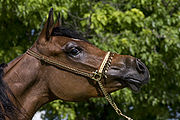
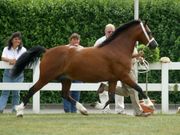
Bridle
A bridle is a piece of equipment used to direct a horse. As defined in the Oxford English Dictionary, the "bridle" includes both the headstall that holds a bit that goes in the mouth of a horse, and the reins that are attached to the bit....
. The primary difference between a halter and a bridle is that a halter is used by a handler on the ground to lead or tie up an animal, but a bridle is generally used by a person who is riding
Equestrianism
Equestrianism more often known as riding, horseback riding or horse riding refers to the skill of riding, driving, or vaulting with horses...
or driving
Driving (horse)
Driving, when applied to horses, ponies, mules, or donkeys, is a broad term for hitching equines to a wagon, carriage, cart, sleigh, or other horse-drawn vehicle by means of a harness and working them in this way...
an animal that has been trained in this use. A halter is safer than a bridle for tying, as the bit
Bit (horse)
A bit is a type of horse tack used in equestrian activities, usually made of metal or a synthetic material, and is placed in the mouth of a horse or other equid and assists a rider in communicating with the animal. It rests on the bars of the mouth in an interdental region where there are no teeth...
of a bridle may injure the horse's mouth if the horse sets back while tied with a bridle, and in addition, many bridles are made of lighter materials and will break. On the other hand, a bridle offers more precise control.
One common halter design is made of either flat nylon
Nylon
Nylon is a generic designation for a family of synthetic polymers known generically as polyamides, first produced on February 28, 1935, by Wallace Carothers at DuPont's research facility at the DuPont Experimental Station...
webbing or flat leather
Leather
Leather is a durable and flexible material created via the tanning of putrescible animal rawhide and skin, primarily cattlehide. It can be produced through different manufacturing processes, ranging from cottage industry to heavy industry.-Forms:...
, has a noseband
Noseband
A noseband is the part of a horse's bridle that encircles the nose and jaw of the horse. In English riding, where the noseband is separately attached to its own headstall or crownpiece, held independently of the bit, it is often called a cavesson or caveson noseband...
that passes around the muzzle with one ring under the jaw, usually used to attach a lead rope, and two rings on either side of the head. The noseband is usually adjusted to lie about halfway between the end of the cheekbones and the corners of the mouth, crossing over the strong, bony part of the face. The noseband connects to a cheekpiece on either side that go up next to the cheekbone to meet with a ring on either side that usually is placed just above the level of the eye. These rings meet the throatlatch and the crownpiece. The crownpiece is a long strap on the right-hand side of the halter that goes up behind the ears
EARS
EARS may refer to:* Electoral software* Electronic Arts, Redwood Shores campus.* Emirates Amateur Radio Society...
, over the poll and is buckled to a shorter strap coming up from the left. The throatlatch goes under the throat
Throat
In vertebrate anatomy, the throat is the anterior part of the neck, in front of the vertebral column. It consists of the pharynx and larynx...
, and sometimes has a snap or clip that allows the halter to be removed in a manner similar to the bridle. Many halters have another short strap connecting the noseband and the throatlatch.
The halter design made of rope also has the same basic sections, but usually is joined by knots instead of sewn into rings. Most designs have no metal parts, other than, in some cases, a metal ring under the jaw where the lead rope snaps, or, occasionally, a recessed hook attachment where the crownpiece can be connected. However, in many cases, a loop is formed in the left side of the crownpiece and the right side of the crownpiece simply is brought over the horse's head, through the loop and tied with a sheet bend
Sheet bend
The sheet bend is a bend, that is, a knot that joins two ropes together. Doubled, it is effective in binding lines of different diameter or rigidity securely together, although it has a tendency to work loose when not under load.The sheet bend is related in structure to the bowline...
.
Uses
In addition to the halter, usually a leadLead (tack)
A lead, lead line, lead rope or head collar rope , is used to lead an animal such as a horse. Usually, it is attached to a halter. The lead may be integral to the halter or, more often, separate. When separate, it is attached to the halter with a heavy clip or snap so that it can be added or...
(lead line, lead rope) or leash
Leash
A leash is a rope or similar material attached to the neck or head of an animal for restraint or control...
is used to lead or tie the animal. The lead is attached to the halter most often at a point under the jaw, less often at the cheek, and rarely above the nose. On horses, a lighter version of a headcollar or headstall is also used to attach a fly veil of waxed cotton strands or light leather strips onto a browband. Some Fly mask
Fly mask
A fly mask or fly cap is a mask used on horses to cover the eyes, jaw, and sometimes the ears and muzzle to protect from flies. The mask is semi-transparent and made from a mesh allowing the horse to see and hear while wearing it. The mask may also provide some protection from UV-light...
s are also made in a similar pattern to a headcollar and are often fastened with velcro tabs. These masks may also have ear and nose protection added to them. On both horses and dogs, halters may be used to attach a muzzle
Muzzle (device)
A muzzle is a device that is placed over the snout of an animal to keep it from biting or otherwise opening its mouth.An Elizabethan collar is a cone-shaped device placed around an animal's neck to prevent biting and sometimes referred to as a muzzle, though its function is more usually to prevent...
.
Safety and security issues
For tying, it is disputed if a halter should be made strong enough not to break under stress, or if it should give way when tension reaches a certain point in order to prevent injury to the animal. Usually the issue is of minimal concern if a tied animal is attended, and the lead rope is tied with a slip knotSlip knot
A slip knot is one of two different classes of knot. The most common are knots which attach a line to an object and tighten when tension is applied to the free end of the line...
that can be quickly released if the animal panics. However, in cases where a non-slip knot is tied, or a soft rope is drawn tight and the knot cannot be released, or if the animal is left unsupervised, an animal panicking and attempting to escape can be seriously injured. Those who argue that the risk of injury is more of a concern than the risk of escape recommend halter designs that incorporate breakaway elements, such as a leather crownpiece, breakaway buckles, or easily detachable lead rope. Those who believe that escape is the greater danger, (the consequences being animal disappearance or possible injury to the animal or by the animal) or who have concerns that an animal that learns to break loose will be unable to be kept tied at all, recommend sturdy designs that will not release unless the handler deliberately releases a slipknot or cuts the rope. Between the two camps are those who recommend sturdy halters that will not break under normal pulling back by a recalcitrant or frightened animal, but ultimately will break in a true panic situation, such as a fall.
Some users have the animal wear a halter at all times, even when stalled or turned out. Others have the animal wear a halter only when being led, held, or tied. The advantages of leaving a halter on are that the animal is often easier to catch. The disadvantages are that an animal may catch the halter on an object and become trapped or injured in some fashion. While experts advise leaving halters off when animals are turned out, if halters are left on unattended animals, breakaway designs that still will hold for everyday leading are recommended.

